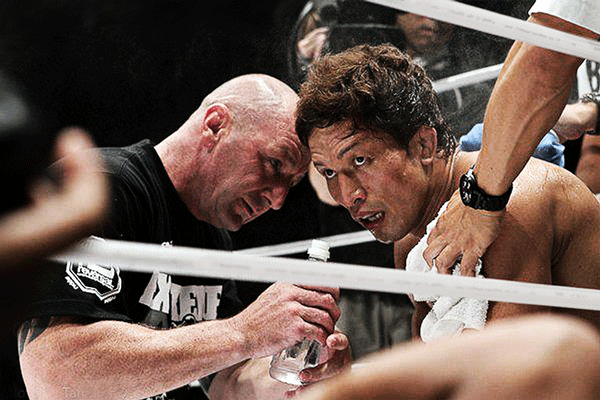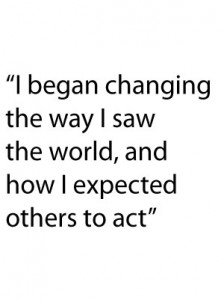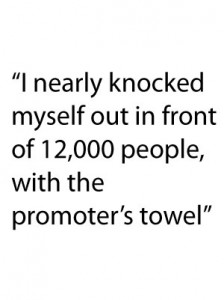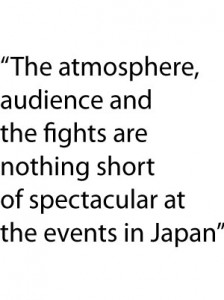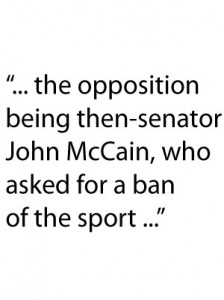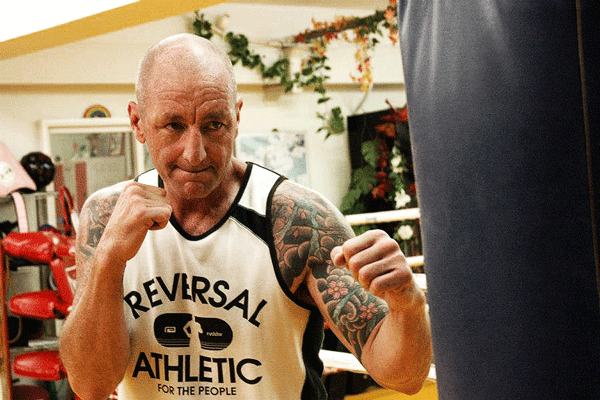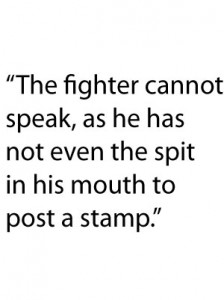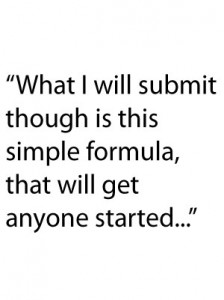MMA trainer Sean Frew, an expert in sport-specific striking and a transitions coach, knows more than a thing or two about Mixed Martial Arts. Tokyo-based Stack Jones met him and learned about the realities of training, differences between different codes, what working with stars such as Miyata Kazuyuki and Hayato “Mach” Sakurai means and how he ended up in Japan in the first place.
I grew up on Miami Beach, and the world famous 5th Street gym was just a stone’s throw from the tough docks where my family’s business was located. When I was just twelve years old, I had the chance to meet Mohammed Ali at what was then known as the best sandwich shop on the beach, Mike’s Neba Heros.
When I shook hands with Ali, my tiny digits disappeared somewhere in his massive grip. I wondered if I would ever see them again.
The boxing legend was incredibly charming, charismatic, and graceful. We exchanged a few jabs, and to me it was elation. Despite all the big talk and rhetoric that Ali was famous for, he always took time out of his busy schedule to stop and chat with children. For this kid, that would be a moment frozen in time.
From that point on I became an avid fight fan. But, after Mike Tyson, Evander Holyfield (who I actually met in Las Vegas while engineering audio for a high rollers gig) and Lennox Lewis, the boxing world got KO’d by the new contenders known as UFC, Dream Dynamite, Shooto, Mixed Martial Arts (aka MMA), K-1 and the like.
Nowadays, if you want to see a real fight, it’s not organized and monopolized in Vegas. It’s spread throughout arenas all around the globe, and Japan has its share of events, fight fans, and extraordinary fighters.
His name is Sean Frew, and if you see the guy on the street, at first glance you’d probably want to cross to the other side. But, if you can get beyond the chiseled frame, the towering hulk, tattoos and intense demeanor, you’ll find a genuine guy who’s dedicated to his family, and to the martial arts.
Sean Frew has worked with many of the best names in the industry, and he’s nothing less than the real deal.
I had a chance to meet Sean Frew shortly after Japan’s triple disaster in 2011, while the entire nation was still in chaos. We agreed to do an interview at a later date, and we finally found the time to sit down and do it. So, here it is, going the distance with one of Japan’s premiere trainers, Sean Frew.
Stack Jones: Before we get into the historical aspects of the fight world, let me ask you what events are taking place in the near future?
Sean Frew: I’m scheduled to work with Joachim Hansen, a UFC, Dream, Dynamite and Shooto veteran from Norway. I’ll do lead up, as well as act as his corner man at the New Year’s Eve event at at the Saitama Super Arena.
Stack Jones: You also do a lot of seminars. Do you have any coming up?
Sean Frew: Yes, Miyata Kazuyuki and I will collaborate together at many seminars that are scheduled in Australia this mid-January.
Stack Jones: Any other people you’ll be working in the near future?
Sean Frew: I’m going to be working with WBC heavyweight champion Fabiano Cyclone, who will also be competing at the NYE event. I’m also scheduled to work with Emi Fujino, who is a well-known female MMA fighter.
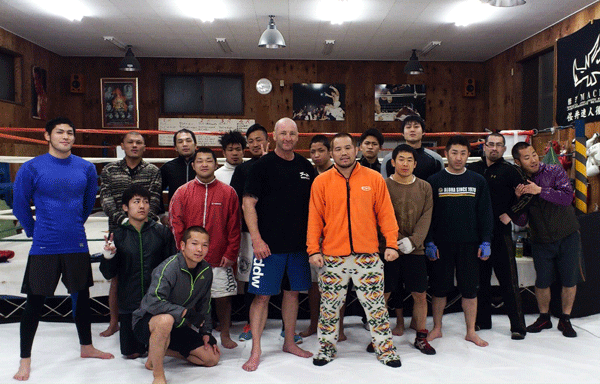
Spot Sean in the middle of the group, with Hayato “Mach” Sakurai in the orange jacket next to him (by Emiko Sakurai at Mach Dojo, Ryugasaki, Ibaraki)
Stack Jones: Where were you raised?
Sean Frew: I was raised in an multi-cultural part of Sydney, Australia, which was perhaps a little rougher than some of the other suburbs close to the city. Having said that, Sydney and Australia is a beautiful place to grow up.
Stack Jones: What motivated you to get involved in the martial arts?
Sean Frew: I always loved the martial and fighting arts ever since I can remember. When I was in elementary school, I won a drawing contest, and the prize was a choice of books. I chose one on ancient warrior swords. I also went to a fancy costume party during that period of my life. I went as Shintaro the samurai. TV programs that were popular around that time also fueled my initial interest.
Television programs such as Phantom Agents (Ninja butai gekko), and Akikusa Shintaro (The Samurai), as well as movies like Fists Of Fury also had an impact on me. I really wanted to take Kung Fu classes, but with the soaring popularity of the arts, also came the large fees for classes, something my parents weren’t about to pay. At that time there was also Ali, and later Larry Holmes, Hearns, Hagler, Leonard, and Duran. The boxing and martial arts at the time really complimented each other.
Stack Jones: In the States, the TV show Kung Fu became a national sensation overnight. From that point on it was everything Asian. Everyone wore bamboo flip-flops, and anyone who could afford it took karate classes. So, there were some obvious parallels even on the other side of the globe. Do you have any other childhood memories that helped you to commit yourself to martial arts and the fighting sports?
Sean Frew: Yes, my stepfather came on the scene when I was four years of age. He was a tough Croatian who had escaped Austria, and was a political refugee. My mother grew up in the tough working class inner city of Sydney, and we later moved to an even tougher multi-cultural ethnic area. I appreciate those times for helping to make me culturally, and ethnically, tolerant. Such an upbringing taught me important life skills, and I’m appreciative for that. A large part of that period of my life gave me the ability to mentor others in the fighting world.
The celebration of winning and attaining goals shared by my clients, and myself is a real joy, and an added bonus today.
“REALITY KICKED IN”
Stack Jones: How did you end up in Japan?
Sean Frew: Back home I worked as a trainer, and on weekends I worked as security in Sydney’s largest nightclub. None of what I was doing seemed like work. My crew worked and trained together. Life was great. My girlfriend at the time was Japanese. As in many mixed cultural relationships, there were certain gaps, so I wanted to go and learn more about where she came from. We decided to visit Japan for a few weeks, and I was impressed with the country and culture, and amazed at how totally different everything was from anything I’d ever known. I decided to return, and stay for a year.
Like most foreigners, I began to working as an English teacher. Reality kicked in. The experience was somewhat different. The novelty wore off. There were many things I enjoyed about the country, but some of my experiences were far from ideal. The year was about to finish, and I planned to return home, but I decided to give it another year.
I realized that Japan is not going to change, nor is the world for that matter. Change comes from within. This was a valuable lesson. So, I began changing the way I saw the world, and how I expected others to act. I took responsibility for the way I thought and acted. That was a valuable lesson that I carry with me to this day.
The longer I stayed in Japan, the more I began to reinvent myself. I’ve been here for thirteen years, and now I have a wife and daughter.
Stack Jones: Do you have long-term plans to stay in Japan?
Sean Frew: Our plan is to relocate back to Sydney early next year. My daughter deserves the opportunity of growing up in a beautiful country like Australia, which is ideal for childhood development in certain areas.
Stack Jones: When did it all connect for you that, for better or for worse, dedicating your life to training fighters was what you wanted to do with your life?
Sean Frew: The transition began when I was residing in Tokyo, and training at Omori Gold’s Gym. That’s when I started to become a successful sport specific striking coach. I’m very appreciative of the continued opportunity of working with some of the best elite athletes and trainers on the planet, as well as working at major events, like K-1, Dream, Sengoku, Dynamite and such. I also work as an agent to help fill fighter’s rosters, as well as other interests associated with the sport and business itself.

Sean Frew by Simen Kjellin at K-1 veteran Nicholas Pettas’ A.E Factory (AKA Spirit Gym) in Yoga, Tokyo
Stack Jones: Who are some of the most talented fighters you’ve worked with?
Sean Frew: Most directly, Joachim Hansen, Miyata Kazuyuki, Mach Sakurai, Nicholas Pettas, Darren Uyenoyama, Yasubey Enomoto, Roxanne Modaferri, Ian Schaffa, and… ah, there’s just too many to name.
Stack Jones: Do you have any Japan specific stories you’d like to share?
Sean Frew: There are so many, and some that I’m not going to mention for the privacy reasons. But here’s one story that is entirely unique to Japan.
Often when foreign fighters come to Japan they have to cut weight. Sometimes as much as four to five kilograms in a matter of hours. So, they need to use a sauna. However, most of the hotels and gyms that the fighters stay and train at refuse to let them use the saunas because they have tattoos. You can guess what percentage of foreign fighters and their teams have tattoos. This is unique to Japan! So what do the fighters do? They run the shower in their rooms and place a towel under the door, or they take a hot bath with certain salts to make them sweat. But nothing works as well as a sauna.
Stack Jones: Do you have any funny stories related to the fight world?
Sean Frew: I won’t tell one at another expense, but I will share one about myself.
I was working with Perter Graham’s corner for an MMA Sengoku event, which was held at the Saitama Super Arena. It was between rounds and I jumped in the ring to instruct the fighter, and all that…
The towels we were using were provided by the sponsor, and were much larger than usual.
I stood up and raised the towel above my head to generate some wind to cool the fighter down.
I brought the towel down, and boom, next thing I knew, something caught me from behind and drove my head down. I slammed my forehead onto my knee, which left me dazed. I nearly knocked myself out in front of 12,000 people, with the promoter’s towel. I’m sure some of the audience picked up on it.
“THAT’S THE PIECE OF THE PUZZLE THAT I PROVIDE”
Stack Jones: Talk about K-1, and MMA styles. What’s the difference?
Sean Frew: K-1 is a kickboxing event. I worked with Nicholas Pettas for a while. He’s a K-1 heavyweight and ex-Kyoshinkai veteran. I worked with his Kohai (junior) Koichi Pettas Watanabe also. I also worked with Kubo Yuta, who is a K-1 light weight, and with Ian Schaffa. I also worked with Danilo Zanolini, who’s based out of Nagoya. MMA means mixed martial arts, which is where my success is most prominent. I’m an expert in MMA sport specific striking, and as a transitions coach.
Stack Jones: What does that all really mean?
Sean Frew: Well, Brazilian Jiu Jitsu, wrestling, judo, grappling, as a base for ground game is combined with Muay Thai and Boxing as a stand up base. This does not equate to a well-rounded MMA fighter.
Well, it can to a certain degree, but not at elite level. There needs to be an understanding of different tools and targets specific to the sport, range, center of gravity, with feet apart, angles, footwork and certain transitions to be able to link things up to allow either the striker or grappler to make the necessary transitions from one to the other smoothly and effectively. That’s the piece of the puzzle that I provide.
I also like to include a certain psychology in everything mentioned when working with a fighter on techniques and strategies. It’s an entire process and package.
Stack Jones: What’s it like being in the moment during one of those events?
Sean Frew: My good friend and veteran UFC, Pride, Shooto, and Dream event fighter Joachim Hansen is in Japan training, and he’s asked me to work with him pre-fight and at the prestigious New Year’s Eve event, scheduled to be held at the Saitama Super Arena. The events that are held in Japan are like nowhere else. The atmosphere, audience and the fights are nothing short of spectacular.
The Japanese really know how to put on these events, dramatic fighter entrances, the stage, the pyrotechnics, lighting, and sound. It’s really an entertaining evening. People are well dressed, and it’s an event you can take the family to. This is evident when you look at the audience. About 30% are women and there are many children as well.
Stack Jones: Tell us more about the seminars?
Sean Frew: I’m working with Miyata Kazuyuki, a former Olympic wrestler, and prominent MMA fighter. I’ve worked with him as trainer for nearly five years, and we’ve teamed up to seminars that will cover many aspects of wrestling, judo, grappling, and the sport specific striking techniques and concepts I mentioned earlier.
MMA is still a young sport in Australia, but much like the rest of the world, there’s rapid growth and expansion. Australia has some good Brazilian Jujitsu, and Muay Thai fighters, but is in real need of the wrestling aspects and specific striking methods that Miyata and myself will be introducing.
“IT’S AN ART FORM MOVING FORWARD AS FAST AS THE IT INDUSTRY”
Stack Jones: Can you give us more specific information about the MMA?
Sean Frew: MMA is a name made familiar by American promotion UFC (Ultimate Fighting Championship) that held it’s first event in 1993. The sport is now the fastest growing sport on the planet and it’s evolution as a sport, and art form is moving forward as fast as the IT industry right now.
While the UFC lays claim to being the founder of MMA in America, fans and audiences should understand the concept was around for many years in Brazil prior to the UFC, and was known as Vale Tudo.
Rorion Gracie, a 9th degree BJJ (Brazilian Jiu Jitsu) black belt, was the man who created the UFC in America as a way to introduce BJJ to the world. The initial UFC events are very different to what we find today. The first events saw a mix of martial artists competing, rather than mixed martial artists competing.
By the time the world caught on to the sport, the American fighters who had a wrestling base begin to dominate. But now another evolution exists. One that I feel the world enjoys more. That being the traditional techniques from martial arts. With fighters like Ryota Machida, Jon Jones, and Anderson Silva as prime examples.
When Japan MMA and world-renowned event PrideFC was at it’s peak, the UFC was having a wrestling match of it’s own, the opposition being senator John McCain, who asked for a ban of the sport, and the state athletic commission UFC lost it’s PPV (Pay Per View) channel and ended up only broadcasting to a much smaller audience.
In the meantime PrideFC Japan not only had no opposition, but they had super arena’s, large sponsors large budgets, and a mega viewing audience via Fuji 8 TV, as well live audience with a record 91,000 at a collaboration Dynamite NYE event in 2003.
So, I was in the right place at the right time. The Pride events later became Hero’s, Sengoku, and Dream, which is where I gained much of my experience along with K-1 and working at other events domestically and internationally.
“HE DROPS 4.7 KILOGRAMS IN TWO HOURS”
Stack Jones: How do fighters make weight and manage to perform at peak level for the fight?
Sean Frew: There are specific techniques that fighters use to cut weight and bounce back. Most of which is water retention. In recent times certain fighters at elite level have the ability to cut ten kilograms in about a week. This allows them to make weight at the weigh in, usually scheduled the day prior to the event, and then re-gain ten to twelve kilograms for fight night itself. However, not every fighter does this.
It’s a case-by-case scenario, as too are the methods applied. I can give you one scenario that a fighter I worked with on many occasions does. He cuts five kilograms in five days. Then drops 4.7 kilograms in two hours, and another 300 grams while driving to the weigh in. Then bounces back ten kilograms come fight time the next day. He’s at peak performance, and ready to go.
Stack Jones: How is that possible?
Sean Frew: During that time the choice of foods and volume are paramount to achieving this, as too is the training. The fighter has a smaller than usual breakfast, a usual size lunch, and a smaller than usual size dinner with no carbs at night. He will eat only salad, and a small piece of chicken or fish and two avocados to feel full.
Cutting out sodium and isotonic drinks is essential. This particular fighter eats all things raw, even the meat, which is thinly sliced. This is done to keep the essential enzymes alive. Calories are burnt during sleep, so longer than usual sleep is applied, which helps with the rest and recovery as well. Come the morning of the weigh in, the fighter is four to five kilograms over weight. Are the fighter and team concerned? No, they’ve done this many times before.
The fighter puts on two sauna suits and get’s his heart rate up. He then jumps in the sauna for fifteen minutes, then out for ten minutes, in again for ten, then out again for fifteen, he enters the sauna again for another five minutes, then sits outside for forty minutes, still with the double layered sauna suit on.
He then removes the suit and has a warm shower, dries off, and rugs up in warm clothes to drive to the weigh in. During that time, and at the weigh in, the body core temperature is still very high, so the fighter continues to drop water. The fighter cannot speak, as he has not even the spit in his mouth to post a stamp. He needs to be cared for all the time by his team.
I’m always on hand with a dioralyte drink immediately after the fighter makes weight. Then it’s on to isotonic sports drinks that are slowly consumed. The fighters diet literally goes from being a baby to an adult in a day. He starts on mushed up baby foods, then fruits, then softer foods such as pasta and such, then eventually eats a full steak, some potatoes and vegetables, cake and whatever else he chooses at that stage.
He either has an IV drip waiting or will visit a clinic where one is waiting. The IV drip usually contains, glucose, aminos and garlic, and there are several different mixes available.
Come fight night, the fighter has become full-bodied, strong replenished well-rested, and ready to go.
As I mentioned, I’ve worked with many fighters, and all have their own way to get fight ready. Some techniques are similar, and some are radically different. This is just one of the methods, and shared it for this article to show the level of commitment professional, and elite athletes employ into their lives as top level athletes. And that’s what MMA fighters are you know. Most are good, friendly, honest, hardworking, family people who have chosen the sport as their occupation.
They are far removed from the perception of two animals in a cage or a human cockfight.
“FOCUS ON WINNING”
Stack Jones: Do you have any advice for any up-and-coming fighters?
Sean Frew: Yes, if you’re starting, it’s important to have good foundation in any of the ground disciplines along with a combination of boxing and/or Muay Thai and/or kickboxing. This foundation is mandatory. There are other techniques needed if you want to equate to a MMA fighter at any real level. The main thing initially is to have fun, and find what your strengths are, and where your natural attributes are, then build from there.
In regards to those who have already acquired certain skills and want to further their careers, I would say, focus on winning. That may sound obvious at first, but there’s a whole mindset and an array of strategies and skills to helping to attain that. These are things that I share with the clients that I train, and at my seminars.
The difference between good athlete’s and elite athlete’s is not the ability to win and perform well at the top level of the sport, but rather, the ability to do so consistently. To enter any major event, there is a criteria by which matchmakers primarily look for. What has bargaining power most is a recent string of victories, ideally at certain events and via way of worthy opponents.
Stack Jones: How do fighters keep the unwanted bulk down, and obtain those hard to get lean muscles? What advice do you have for people that need to get back to a healthy lifestyle?
Sean Frew: In regards to the general public who are interested in simply cutting weight, burning fat, and building and maintaining quality lean muscles. Once again, that a case by case scenario, as their are different way, and some work better for certain people, and that’s something you can research and try out yourself, via the wide resources available on the health and fitness industry. What I will submit though is this simple formula, that will get anyone started…
First, find the time for regular exercise. At least 3-4 times a week if you can. And if you’re sincere about it, we all can find that time.
When it comes to nutrition, learn about what foods to eat, when, how much, why and how. Consider the calories that are going into your body and the one’s that are being spent. Certain exercise and products on the market will help transform your body, and will equate to more muscle, less fat, and eventually lean quality muscle.
Weight training will help with the muscle growth and development and aerobic exercise such as walking, riding a bike and such will help with fat burning. It’s important to note that those sincere about burning fat will need to spend quite some time each day or at least each training session doing so. The window to doing this is not such a high heart rate as some may imagine, but rather an even one over time, approximately 120-130 bpm (beats per minute) for around 40-45 minutes.
Products widely used for muscle growth, recovery, and fat burn are BCAA (branch chain amino acids) Glutamin, and L-Carnitine. All are widely available and all above board.
But remember, these are supplements to supplement and assist, the key ingredients are nutrition, training, and lifestyle, as well as an understanding about yourself, and your body type.
I encourage everyone to research for themselves. It’s very enjoyable once you get into the swing of things, and as a result will actually increase energy levels in your daily life, as well as other obvious health benefits, and I go so far to say a new and brighter outlook and quality of life in general.
So what you waiting for, give it a go if you haven’t already. You’ll love it. Just as the millions and millions around the globe are doing right now at this moment. The way in which you choose to get out there and exercise, as well as employ certain nutrition into your own life is a personal choice and totally up to you. Which makes it even more fun.
Sport and exercise is just an important part of life as, going to work, doing the washing, buying the groceries, taking the children to school, and whatever else it is that people find themselves doing routinely in their daily lives. It’s as simple as going for a walk, visiting a gym, or diving in the ocean.
Interview by Stack Jones. See Sean Frew’s website for more details.
Main image of Sean Frew ringside with Kazuyuki Miyata at Dream event Miyata Kazuyuki vs Caol Uno: Photo by Taro Irei.

